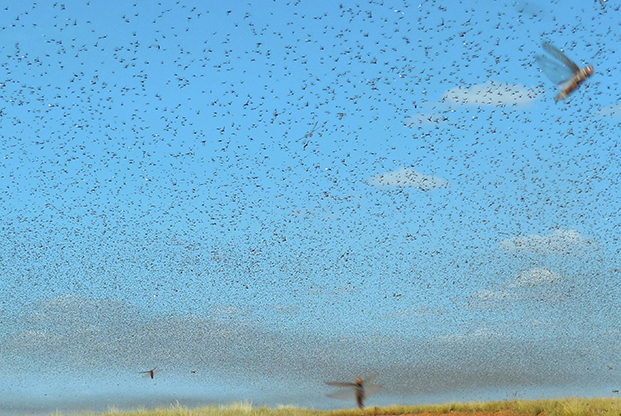
Military strategists have long recognized how swarming can confuse and overwhelm an enemy. Photo: Iwoelbern
Lions and wolves attack their prey in packs, using speed and maneuver to cut off larger beasts from protective herds. Schools of fish and flocks of birds mass together to protect themselves from predators. Bees swarm to defend their hive and queen.
Military strategists have long recognized how swarming can confuse and overwhelm an enemy. As far back as 53 B.C., swarms of Parthian archers on horseback defeated Rome’s larger, better-equipped forces in the Battle of Carrhae.
In the 2002 Millenium Challenge war game, retired Marine Lt. Gen. Paul Van Riper’s team deployed a barrage of missiles, ships, low-flying planes, and swarms of explosive-laden kamikaze speedboats to completely disrupt a major military exercise. Within minutes, Van Riper’s red team overwhelmed the carrier battle group’s Aegis radar, sinking 19 ships, including the carrier and a fleet of amphibious ships. So devastating was the loss that, to save the exercise, planners paused the clock, restored the naval force, then restarted the exercise under new rules.
Now, swarming is going remote control. Just last year, the Russian-controlled Khmeimim Air Base in Syria fended off a coordinated attack by 13 drones in Syria’s Latakia province. While the Russians were able to defend themselves, Russian Deputy Defense Minister Alexander Fomin accused the United States of coordinating the attack, saying, “only a technologically advanced country has access to such tools.”
The Pentagon denied the claims, but whoever managed to launch the attack had clearly mastered the coordination necessary to mass forces against a stationary enemy.
Modern civilian drones are increasingly sophisticated, and civilian firms in both the US and China have demonstrated remarkable agility in operating swarm formations. At the 2018 Winter Olympics, US chipmaker Intel broke a Guinness World Record (previously held by China), launching 1,218 “Shooting Star” drones in a nighttime light display that both amazed the global audience and sent chills down the spines of anyone concerned about aircraft safety. The swarm of tiny drones flew tightly coordinated patterns, morphing from athletes participating in various Olympic sports into the iconic five-ring Olympic symbol.
That same technology could be weaponized simply by flying into the path of a jet at takeoff or by persistently disrupting airfield operations. Increasingly powerful artificial intelligence algorithms and “hive-mind mechanics” could enable fleets of micro-drones to easily overwhelm or harass enemy air operations.
As in nature, swarms can produce a collective intelligence that enables a group to move in sync to accomplish an objective.
US defense researchers are pursuing multiple programs to study and develop technology to employ and defend against swarms.
This month, Air Force Magazine delves into both sides of the equation. In “The Looming Swarm,” News Editor Amy McCullough explains how swarming can be applied across the spectrum of warfare—from initial forays into enemy airspace in an anti-access, area-denial scenario, to using a coordinated flock of drones to map the progress of a wildfire.
Then, in “The Drone Zappers,” Senior Editor Rachel Cohen reports on progress developing high-power lasers and microwave weapons to defend bases against swarming drone attacks by knocking threats out of the sky.On both the offensive and defensive fronts, researchers agree they still have much to learn. But the potential is enormous. Investing in technology, tests, and experimentations now will help assure that the US Air Force is ready.